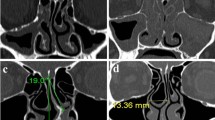Abstract
Otitis media (OM) is a common health problem. Nasal airways play an important role in etiopathogenesis of OM. The aim of this study is to evaluate nasal airways by objective methods in chronic otitis media (COM) cases. The relationship between the course of the disease and nasal parameters is also investigated. Fifty-six patients who had chosen an operation for chronic otitis media were included in the study. The control group was composed of 30 healthy patients. Patients were subjected to acoustic rhinometry and rhinomanometry. Nasal airway resistance and cross-sectional area measurements were taken. The results of the COM group and the control group were compared. Cases were classified by the course of the disease such as suppurative/progressive/active and non-suppurative/inactive and the nasal parameters of these sub-groups were compared. In cases with unilateral COM, nasal cavity results from both sides were compared. The nasal airway resistance of the COM group was statistically significantly higher than the control group (p < 0.05). However, there was no difference in cross-sectional area measurements. There was no significant difference between the suppurative/progressive/active and non-suppurative/inactive groups. However, the suppurative group had higher nasal resistance (p > 0.05). There was no statistical difference between the measurements of each side in unilateral COM cases. This study found that COM cases have greater nasal airway resistance. No significant difference was found in cross-sectional area measurements so the increase in resistance may be linked to mucosal rather than structural changes. There was no evidence for a relationship between the course of the OM and nasal airway parameters.
Similar content being viewed by others
References
Semaan MT, Megerian CA (2006) The pathophysiology of cholesteatoma. Otolaryngol Clin North Am 39(6):1143–1159
Licameli GR (2002) The eustachian tube. Update on anatomy, development, and function. Otolaryngol Clin North Am 35(4):803–809
Sismanis A (1991) Otitis media: the pathogenesis approach. Assessment and treatment of associated upper respiratory tract pathology. Otolaryngol Clin North Am 24(4):947–955
Watson C (1990) Chronic otitis media: the significance of nasal obstruction. Clin Otolaryngol Allied Sci 15(5):435–438
Jörgensen F, Holmquist J (1984) Toynbee phenomenon and middle ear disease. Am J Otol 5(4):291–294
Vogt K, Jalowayski AA, Althaus W, Cao C, Han D, Hasse W, Hoffrichter H, Mösges R, Pallanch J, Shah-Hosseini K, Peksis K, Wernecke KD, Zhang L, Zaporoshenko P (2010) 4-Phase-rhinomanometry (4PR)—basics and practice. Rhinol Suppl 21:1–50
Nathan RA, Eccles R, Howarth PH, Steinsvåg SK, Togias A (2005) Objective monitoring of nasal patency and nasal physiology in rhinitis. J Allergy Clin Immunol 115(3 Suppl 1):S442–S459
Ciprandi G, Cirillo I, Pistorio A, La Grutta S (2008) Relationship between rhinitis duration and worsening of nasal function. Otolaryngol Head Neck Surg 138(6):725–729
Sobol SE, Fukakusa M, Christodoupoulos P et al (2003) Inflammation and remodeling of the sinus mucosa in children and adults with chronic sinusitis. Laryngoscope 113:410–414
Gluck U, Gebbers J (2000) Epithelial changes in seasonal allergic rhinitis throughout the year. ORL J Otorhinolaryngol Relat Spec 62:68–75
Ishii J, Naito K, Miyata S et al (2000) An electron microscopic study of the relation between epithelial cell damage and eosinophils in the nasal mucosa of patients with nasal allergy. Arerugi 49:1156–1162
Filipović SA, Janosević L, Andrić V, Ugrinović A (2009) Clinical evaluation of eustachian tube transience and function in patients with different types of increased nasal resistance. Vojnosanit Pregl 66(5):353–357
Yilmaz MS, Guven M, Buyukarslan DG, Kaymaz R, Erkorkmaz U (2012) Do silicone nasal septal splints with integral airway reduce postoperative eustachian tube dysfunction? Otolaryngol Head Neck Surg 146(1):141–145
Scarano E, Fetoni AR, Picciotti P, Cadoni G, Galli J, Paludetti G (2003) Can chronic nasal obstruction cause dysfunction of the paratubal muscles and otitis media? An experimental study in developing wistar rats. Acta Otolaryngol 123(2):288–291
Cingi C, Altin F, Cakli H, Entok E, Gurbuz K, Cingi E (2005) Scintigraphic evaluation of nasal mucociliary activity in unilateral chronic otitis media. J Laryngol Otol 119(6):443–447
Hadas E, Sadé J (1979) Clearance by the mucociliary system in ‘simple chronic otitis media’. J Laryngol Otol 93(8):781–783
Conflict of interest
This manuscript is not published previously, and all authors declare there are no conflicts of interest.
Author information
Authors and Affiliations
Corresponding author
Rights and permissions
About this article
Cite this article
Güçlü, O., Şahin, E.M., Tekin, K. et al. Evaluation of nasal airways by objective methods in chronic otitis media. Eur Arch Otorhinolaryngol 270, 1263–1266 (2013). https://doi.org/10.1007/s00405-012-2122-4
Received:
Accepted:
Published:
Issue Date:
DOI: https://doi.org/10.1007/s00405-012-2122-4




